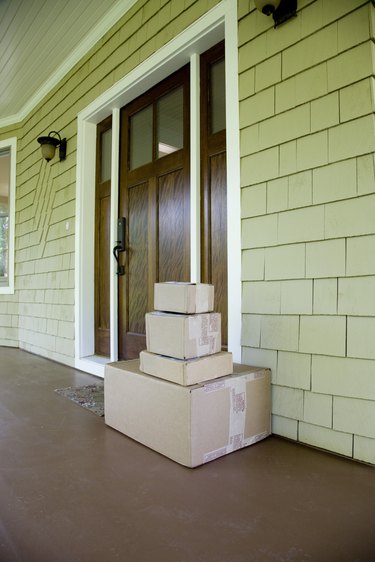Things You'll Need
Screwdriver
Drop cloth
Putty knife
Hammer
Face mask
Protective eyewear
Spackling compound
Medium-grit sandpaper
Random orbital sander or sanding block
Vacuum with hose attachment
Water
Lint-free cloth
Disposable bowl
Two-part epoxy
Foam roller
Wood veneer sheets
Razor knife
Paintbrush
Polyurethane

Laminate exterior doors are prone to peeling, splitting and bubbling. The laminate may separate from the underlying door due to factors such as age, sun exposure or moisture. Once the separation begins, additional moisture will invade the space between the laminate and the underlying surface, resulting in rapid deterioration. Dents from a break-in or mishap also affect the door's overall appearance. In both cases, you must remove the laminate and apply a fresh layer of wood veneer.
Step 1
Remove the door handles. Open the door and remove the screws that are affixing the handle and latch plate to the door and remove the screws on the side of the door.
Video of the Day
Step 2
Remove the door from its hinges. Open the door and use a screwdriver to remove the screws that are affixing the door to the hinge plates. There will be a hinge plate at the top, near the middle and near the bottom of the door.
Step 3
Lay the door on a work bench or atop a drop cloth on the floor, with the exterior side facing the ceiling.
Step 4
Remove the old laminate. Position the edge of a putty knife at the point where the laminate meets the door surface and tap the tip of the putty knife handle with a hammer to push the blade forward, thereby separating the laminate from the underlying surface.
Step 5
Wipe spackle compound into dents. Use a putty knife to smear the spackle. Smooth the surface with the putty knife and allow the compound to dry, per the instructions on the packaging.
Step 6
Put on a face mask and protective eyewear.
Step 7
Sand the door surface to smooth the spackle compound and to remove traces of adhesive used to attach the laminate. Use medium-grit sandpaper on a sanding block or a random orbital sander.
Step 8
Remove dust generated by the sanding process with a vacuum hose attachment.
Step 9
Wipe down the door's surface with a damp lint-free cloth to remove traces of dust. Remove your protective eyewear if desired.
Step 10
Mix two-part epoxy compound in a disposable bowl. Mix the compound with a putty knife.
Step 11
Apply the epoxy compound to the door's surface with a foam roller.
Step 12
Apply epoxy compound to the back of the wood veneer strips.
Step 13
Adhere strips of wood laminate to the door's surface. Apply strips at the top and work toward the bottom of the door, so the wood grain is vertical. Position the strips as close as possible without overlap.
Step 14
Trim the wood laminate with a razor knife as it's applied to the door. Smooth the laminate with your hands, then trim away excess laminate to ensure a perfect fit around windows, molding and the holes for the door handle.
Step 15
Allow the epoxy to dry and harden. Consult the product packaging for the recommended drying time.
Step 16
Apply three to four coats of outdoor polyurethane. Brush an even coat of polyurethane over the entire door and allow it to dry before applying a new coat. The polyurethane will seal the wood, protecting it from the elements. Use a tinted polyurethane if you need to alter the color of the wood laminate to match the trim pieces. Allow the polyurethane to dry, per the directions on the package.
Step 17
Hang the door on its hinges. You may need a friend to hold the door in an upright position while you run screws through the hinge plates and into the edge of the door.
Step 18
Replace the door handle or latch. Run the exterior handle through the hole in the door and fasten it to the door's surface with screws. Repeat with the handle on the other side of the door, then insert the screws that run into the side of the door.
Tip
If you remove the old laminate in large, intact strips, use these pieces as a template for cutting the new pieces. Place the old laminate on top of the new laminate and trace the outline onto the new wood. Cut along the tracing line with a razor knife.
This project will take at least two days to complete. Consider how you will secure your home during the repair process. A locking storm door is ideal. Otherwise, you may opt to place a board over the doorway.
Warning
Apply two-part epoxy and polyurethane in a well-ventilated location.
Video of the Day